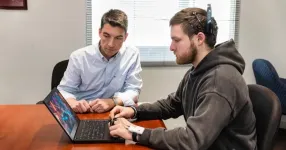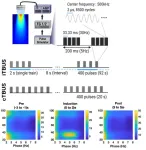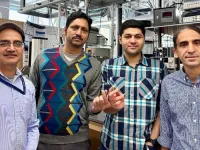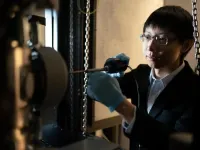(Press-News.org) Machines still can’t think, but now they can validate your feelings, based on new research from New Jersey Institute of Technology Assistant Professor Jorge Fresneda.
Fresneda started his career as a chemist and then became an expert in neuroanalytics. He studies how measurements of brain activity and skin conductance can predict a person’s emotions with high accuracy, and how such information can be used in fields such as entertainment, management, marketing and well-being.
“Neuromarketing is a subfield within marketing that uses sensors for marketing purposes, to inform managers and make better marketing decisions,” Fresneda explained. He collaborated with colleagues in NJIT’s Martin Tuchman School of Management — Professor Jerry Fjermestad and doctoral student David Eisenberg — plus Virginia Tech graduate research assistant Tanmoy Sarkar Pias, to publish Neuromarketing Techniques to Enhance Consumer Preference Prediction earlier this year at the 57th Hawaii International Conference on System Sciences.
Currently, most marketing research relies on people self-reporting their responses to anything from sale prices to dramatic videos. Fresneda found that if you add electroencephalograms (EEG) probes, which detect brain waves, and galvanic skin response (GSR) sensors, which measure electrical conductance, then you can predict people’s feelings about marketing stimuli with greater accuracy than their own self-reporting. That’s determined by feeding the various sensor results through graphing algorithms and then comparing them to existing academic databases.
The field isn’t as far-fetched as it may sound. Modern EEG equipment, at non-healthcare levels, is small enough to blend into an ordinary Bluetooth headset. And GSR sensors, contrary to sounding Frankensteinian, are already built into the latest Samsung smartwatches. Fresneda added that one of the most impressive sensor networks may be deployed at the North Jersey’s American Dream mall. Although not fully in use, he said it’s potentially capable of collecting GSR data from smart devices, or from radio-frequency data transmitted by smart shopping bags, and linking that information to social media profiles.
At a demonstration for retail store managers, the opinions were mixed. Fresneda said all but two appreciated the technology’s potential to provide feedback to managers and sales staffers, on their own performance. Those who were against it were very strong in their opinions about privacy concerns. As a consumer, Fresneda said he would be willing to wear such technology, since most shoppers already allow companies like Amazon, Google and Facebook to track us. “If I get value in return, yes, of course. But you have to show me,” he said. “Otherwise, I would be legitimately scared.”
“Furthermore, the same algorithms can be used to measure emotional reactions, such as calmness or fear, which can potentially measure people’s reactions to various emotionally charged experiences,” their paper stated. “Future research could use the same algorithm to anticipate liking or choices of consumers for different kinds of products, as well as in new product development, beyond music videos. Moreover, the same neural analytics could be applied to tracking people’s emotional states in other contexts, including customer satisfaction, worker satisfaction, or even employee productivity tracking.”
Fresneda and colleagues are now working on a follow-up journal article, based on tests of applying the technology to fields such as consumer-oriented finance. It’s been submitted for fast-track consideration to AIS Transactions on Human-Computer Interaction. The team is also in the early stages of developing patents that apply their research to healthcare and videogames.
END
NJIT marketing experts measure brain waves and skin current to predict emotions
2024-02-23
ELSE PRESS RELEASES FROM THIS DATE:
Babies use immune system differently, but efficiently
2024-02-23
ITHACA, N.Y. – Scientists have long believed that a newborn’s immune system was an immature version of an adult’s, but new research from Cornell University shows that newborns’ T cells – white blood cells that protect from disease – outperform those of adults at fighting off numerous infections.
These results help clarify why adults and infants respond differently to infections and pave the way for controlling T cells’ behavior for therapeutic applications.
This discovery was described in a paper published in Science Immunology on Feb. 23, co-led by Brian Rudd, associate professor of microbiology ...
Cloud clustering causes more extreme rain
2024-02-23
Understanding cloud patterns in our changing climate is essential to making accurate predictions about their impact on society and nature. Scientists at the Institute of Science and Technology Austria (ISTA) and the Max-Planck-Institute for Meteorology published a new study in the journal Science Advances that uses a high-resolution global climate model to understand how the clustering of clouds and storms impacts rainfall extremes in the tropics. They show that with rising temperatures, the severity of extreme precipitation events increases.
Extreme ...
Mindfulness at work protects against stress and burnout
2024-02-23
A new study has revealed that employees who are more mindful in the digital workplace are better protected against stress, anxiety and overload.
Researchers from the University of Nottingham’s Schools of Psychology and Medicine analysed survey data from 142 employees. The results have been published today in PLOS ONE.
PhD student Elizabeth Marsh from the School of Psychology led the mixed methods study and said: “As work is increasingly mediated by digital technology we wanted to find out the impact this is having on people’s health and whether there are ways to mitigate this. We found that being mindfully and confidently digital should be considered important elements ...
Scientists closer to solving mysteries of universe after measuring gravity in quantum world
2024-02-23
Scientists are a step closer to unravelling the mysterious forces of the universe after working out how to measure gravity on a microscopic level.
Experts have never fully understood how the force which was discovered by Isaac Newton works in the tiny quantum world.
Even Einstein was baffled by quantum gravity and, in his theory of general relativity, said there is no realistic experiment which could show a quantum version of gravity.
But now physicists at the University of Southampton, working with scientists in Europe, have ...
Revolutionary brain stimulation technique shows promise for treating brain disorders
2024-02-23
The human brain's adaptability to internal and external changes, known as neural plasticity, forms the foundation for understanding cognitive functions like memory and learning, as well as various neurological disorders. New research conducted by a team led by Dr. PARK Joo Min of the Center for Cognition and Sociality within the Institute for Basic Science (IBS) unveils a novel technique that could transform the treatment landscape for brain disorders. The team developed a non-invasive brain stimulation method called Patterned Low-Intensity Low-Frequency Ultrasound (LILFUS), which holds tremendous potential for inducing long-lasting changes ...
Global warming increases the diversity of active soil bacteria
2024-02-23
Warmer soils harbour a greater diversity of active microbes, according to a new study from researchers at the Centre for Microbiology and Environmental Systems Science (CeMESS) at the University of Vienna. The study, published in Science Advances, represents a significant shift in our understanding of how microbial activity in the soil influences the global carbon cycle and possible feedback mechanisms on the climate. Until now, scientists have assumed that higher soil temperatures accelerate the growth of microbes, thus increasing the release of carbon into the atmosphere. However, this increased ...
Patient mindset training helps care teams
2024-02-23
A new study from Stanford University, published Jan. 19 in Patient Education and Counseling, evaluates the effectiveness of patient mindset training on provider learning and behavior.
Past research shows that what patients think, believe, or expect regarding medical care can influence care outcomes. Patients also have better outcomes when they have more adaptive mindsets about their treatments (e.g., “this treatment will be effective”), their bodies (e.g., “my body is capable”), their illnesses (e.g. “diabetes is manageable”), and their care team (e.g., “I am in good hands”). ...
Dual-energy harvesting device could power future wireless medical implants
2024-02-23
UNIVERSITY PARK, Pa. — Implantable biomedical devices — like pacemakers, insulin pumps and neurostimulators — are becoming smaller and utilizing wireless technology, but hurdles remain for powering the next-generation implants. A new wireless charging device developed by Penn State scientists could dramatically improve powering capability for implants while still being safe for our bodies, the researchers said.
The new device can harvest energy from magnetic field and ultrasound sources simultaneously, converting this energy to electricity to power implants, the scientists reported in the journal Energy & Environmental ...
Study: ‘Hexaplex’ vaccine aims to boost flu protection
2024-02-23
BUFFALO, N.Y. – Recombinant protein vaccines, like the Novavax vaccine used to fight COVID-19, offer several advantages over conventional vaccines.
They’re easy to precisely produce. They’re safe, and potentially more effective. And they could require smaller doses.
Because of these traits, there is much interest in developing recombinant influenza vaccines. To date, however, the Food and Drug Administration has approved only one such vaccine.
A University at Bufalo-led research team hopes to add to that number. It is developing a new recombinant flu vaccine – described ...
New structural insights could lead to mechanical enhancement in alloys
2024-02-23
UNIVERSITY PARK, Pa. — A new class of metallic materials with potential applications in airplane turbines, nuclear reactors and equipment for space exploration can withstand extreme temperatures and resist fractures, but scientists haven’t understood why until now. According to a new study co-led by Penn State researchers, the answer could relate to the material’s short-range order, or the local arrangement of atoms within a material. This knowledge could lead to further improvement in the mechanical performance and damage tolerance of these materials, the researchers said, leading in turn to advancements in the safety and reliability of next-generation ...








